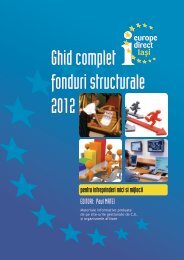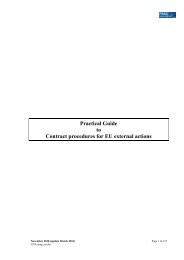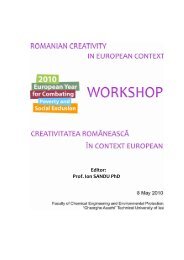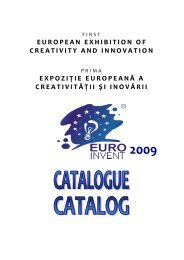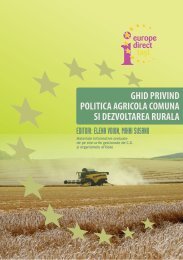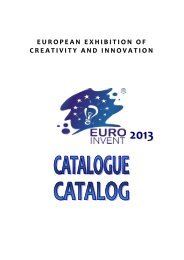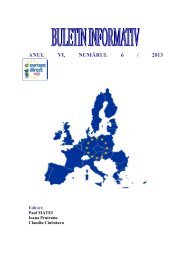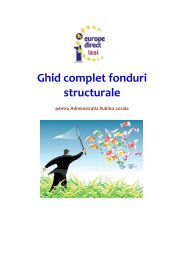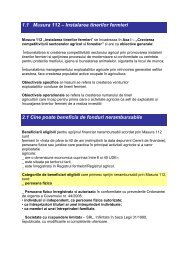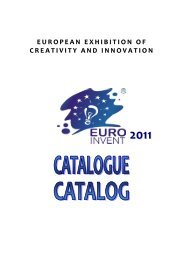2012 - Europe Direct Iasi
2012 - Europe Direct Iasi
2012 - Europe Direct Iasi
You also want an ePaper? Increase the reach of your titles
YUMPU automatically turns print PDFs into web optimized ePapers that Google loves.
EUROINVENT <strong>2012</strong><br />
and the second part consists in a bilingual corpus of Greek and<br />
Latin texts (the selection of the Greek and Latin author’s texts<br />
that contain information on different aspects of the carphatiandnistrian<br />
space and their symbolic value of those texts).<br />
X. 5.<br />
Title<br />
Ethnoarchaeology of Salt Springs and Salt Mountains from the<br />
extra-Carpathian zone of Romania<br />
Authors Alexianu Marius-Tiberiu<br />
Institution „Al.I. Cuza” University of Iaşi<br />
Description<br />
This ethnoarchaeological project on salt – a primordial reference<br />
of humanity – represents a world premiere approach from the<br />
methodological perspective and as spatial extension. Starting<br />
from an original Romanian study of 1992, it continues the<br />
researches carried on by a Franco-Romanian team since 2003<br />
and those within a Romanian Idei CNCSIS (2007-2010)<br />
exploratory project. This approach was tested on the eastern Sub-<br />
Carpathian area of Romania, with impressive results. The<br />
extension of the researches to the whole extra-Carpathian area is<br />
justified by the exigencies specific to a saturated model. Unlike<br />
the previous project, the researches take into account – besides<br />
salt springs – salt mountains/cliffs; the correlations between their<br />
exploitations are thus systematically analyzed for the very first<br />
time in the world. The research has as purpose two main axes:<br />
identifying salt springs and salt mountains/cliffs and the adjacent<br />
archaeological vestiges, and ethnological investigations through<br />
spatial analysis. These data modelled and interpreted in all<br />
dimensions, corroborated with the available ancient and<br />
medieval sources, will constitute a solid referential (valorising a<br />
unique situation in <strong>Europe</strong>) anywhere in the world where there<br />
are archaeological traces of salt exploitation, but not followed by<br />
current non-industrial practices. The researches will underline<br />
the universal invariants, without omitting the idiographic<br />
behaviours.<br />
X. 6.<br />
The researches concerning the biosynthetic capacity of<br />
Title<br />
secondary metabolites depending on the genetic diversity in a<br />
collection of chilli pepper local populations in Western Romania<br />
Authors Lazăr A., Poşta G., Petolescu C., Berar V.<br />
Banat University of Agricultural Sciences and Veterinary<br />
Institution<br />
Medicine Timisoara<br />
The research project aims the quantitative evaluation of the<br />
Description<br />
biosynthesis capacity of secondary metabolites (capsaicin and<br />
carotenoid compounds) in a total of 20 local populations of chilli<br />
Innovative Researches<br />
167



